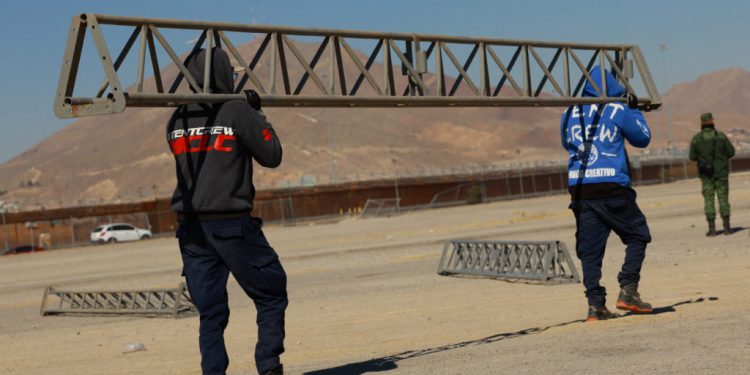CIUDAD JUÁREZ, Mexico (AP) — Mexico pitched sprawling tents on the U.S. border Wednesday as it prepared for President Donald Trump to make good on his promise to reverse mass migration.
In a vacant lot near the border with El Paso, Texas, cranes lifted the metal frames of tent shelters in Ciudad Juárez. Nogales, Mexico – across the street from Nogales, Arizona – announced it would build shelters on soccer fields and in a gymnasium. The border towns of Matamoros and Piedras Negras have launched similar efforts.
WATCH: How the Trump administration is setting the stage for mass deportations
At a border crossing in Tijuana, Mexico, on Tuesday evening, a man shouted to reporters that he was being deported as part of a group arrested that morning in farm fields near Denver. Another man said he was part of a group brought from Oregon. Everyone carried their belongings in a small orange bag.
The two men’s accounts could not be independently confirmed.
The number of people deported Tuesday was lower than the daily average of around 500 last year, Mexican President Claudia Sheinbaum noted during her daily press briefing. Rapidly ramping up deportations — as Trump has promised — faces logistical and financial challenges.
Beyond the tents, the Mexican government is building nine shelters in border towns to accommodate deportees. He said he would also use existing facilities in Tijuana, Ciudad Juarez and Matamoros to house migrants whose appointments to seek asylum in the United States were canceled on Inauguration Day.
Sheinbaum said Mexico would provide humanitarian aid to migrants from other countries whose asylum appointments were canceled, as well as those sent to wait in his country under the revived policy known as Stay in Mexico. Mexico wants to eventually and voluntarily send them back to their countries, she said.
LEARN MORE: Trump launches wave of executive orders as part of promised overhaul of US politics
Mexican Foreign Secretary Juan Ramón de la Fuente and new US Secretary of State Marco Rubio had their first telephone conversation in their new positions.
“It was a very good conversation, very cordial, they talked about migration and security issues,” Sheinbaum said.
After pledging sweeping changes to border and immigration policies, Trump on Monday scrapped the program known as CBP One, which allowed asylum seekers to schedule appointments on their phones before arriving at the border, thus ensuring a certain degree of order. On Wednesday, the Pentagon announced it would send up to 1,500 active-duty troops to the border.
At the Good Samaritan shelter in Ciudad Juarez, the Rev. Juan Fierro was preparing for another change.
In recent years, he has seen the shelter’s population shift from young men crossing a wallless border to work to families seeking asylum. During Trump’s first term, the policy of forcing asylum seekers to wait until the U.S. process in Mexico was completed meant people stayed in the shelter much longer, up to three years, Fierro said.
LEARN MORE: Can Trump change the name of the Gulf of Mexico to the “Gulf of America”?
He is now preparing for the mass deportations promised by Trump. His shelter can accommodate 180 people and can feed about 50, he said. With much lower migration figures over the past year, he had only a fraction of that number this week and is worried about an expected increase.
“This shelter doesn’t have the budget, we’re pretty much working day to day,” Fierro said.
The Mexican government will transport some deportees to their homes inside Mexico. Fierro said he would give the deportees a few months to think about whether to return home, look for work in another Mexican state or try to re-enter the United States.
“Those who want to get to the United States are going to look for a way to do it,” he said.
Márquez reported from Tijuana, Mexico. AP journalists Megan Janetsky and María Verza in Mexico City contributed to this report.


